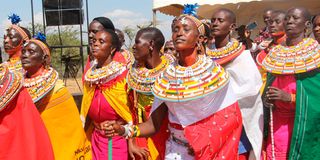Women of peace: The unlikely heroes in end of conflicts in Laikipia's restive area

Women from Laikipia and Isiolo counties dance in Tura village during the commissioning of a borehole aimed at reducing water-related conflicts in October 11, 2024. A few months ago, the two pastoral communities could not see eye to eye owing to entrenched rivalry.
What you need to know:
- On the morning of March 2, 2020, armed youths invaded Narasha village on the boundary of Laikipia and Isiolo counties, torched houses and left 300 people homeless.
- Also destroyed during the retaliatory arson attack by youths from Laikipia County was a primary school, a house belonging to the area chief, a village with newly built manyatta and eco-tourism lodges.
On the morning of March 2, 2020, armed youths invaded Narasha village on the boundary of Laikipia and Isiolo counties, torched houses and left 300 people homeless.
The youth, believed to have come from Tiamamut in Laikipia, appeared to have been on a revenge mission following the previous day killing of four people, including two Naibung’a Community Conservancy rangers. The armed raiders, who drove away livestock, were suspected to have come from Isiolo County.
Also destroyed during the retaliatory arson attack by youths from Laikipia County was a primary school, a house belonging to the area chief, a village with newly built manyatta for a boys’ initiation ceremony and eco-tourism lodges run by a group of local women.
“We were looking forward to making good earnings ahead of the upcoming boys’ initiation ceremony. Our eco-tourism lodges are barely three months old but now they have all been destroyed, taking our one-year investment to the drain in a matter of minutes,” Salante Leburkash narrated despairingly.
Salante, though she never stepped into a classroom, is a respected women leader in her village and a gender rights activist who has been advocating empowerment of women and girls in her conservative pastoral community.
Fast forward to October 2024, Salante and 20 members of her group are beaming with joy as they break into song and dance to celebrate restoration of peace that had been elusive for three years. The eco-tourism village has been re-established on the same spot and the women’s group is back to their income-generating activities.
The women, some of them widowed or single parents, are involved in buying and selling goats, making and trading in beaded ornaments at the locally reopened Oldonyiro and Kimanjo livestock markets in Laikipia and Isiolo counties respectively.
For over three years, the conflict attributed to cattle rustling, banditry attacks, dispute over boundary, and competition over water and pasture persisted, causing fears to residents of Kimanjo, Tiamamut, Kijabe, Koija villages and resulting in deaths of 19 people.
Six schools, two healthy facilities and two livestock markets were closed down for weeks following sustained attacks that culminated in the killing of senior chief Jacob Yiangire in Tiamamut village, Laikipia County, in December 2022.
“Several women were widowed, we lost our sons, our houses were torched by arsonists, forcing us to relocate over 10km away. Before the conflicts, we had a thriving beadwork business, but our workshops were destroyed and [we] retreated back, away from the boundary,” recalls Mary Mosian, a peace committee member from Koija village.
According to a report by the Northern Rangelands Trust (NRT), which has been instrumental in restoring normalcy in the region, some 600 families were displaced on both sides of the boundary, 36 livestock raids carried between 2021 and 2022 where some 2,378 head of cattle were stolen and a total of 4,934 sheep and goats driven away.
Senior government officials, among them then Interior Cabinet Secretary Kithure Kindiki (now Deputy President) and former Rift Valley Regional Commissioner George Natembeya, made visits to the disturbed area at different times to explore ways of dealing with the situation.
However, the security operation provided little relief and criminals took control of Oldonyiro-Nanyuki road, launching frequent attacks on vehicles ferrying food supplies as government security agencies grappled with the best approach to deal with the situation. With the blessings of the government, a peace committee was established, with the NRT tasked with coordinating the efforts.
The peace committee brought representatives from both communities and initially included elders and youths. “Working with the peace committees, we brought more than 300 morans (community warriors) and elders for a whole day meeting where two bulls and 24 goats were slaughtered for a feast as we discussed how the two communities would coexist. However, the attacks still persisted after the meeting,” explains Mr Golicha Jarso, the peace ambassador appointed by the NRT to lead the process.
Mr Jarso and his committee were taken aback when the community reneged on the pledge to keep peace and afterwards decided to invite women for a similar meeting. “When we assembled 500 women from both communities, we realised we had overlooked a key step in seeking a solution to the conflicts. The women told us they were always on the run when a raid to steal cattle was being organised and that unlike the yesteryears, a big section of morans no longer heeded advice from the elders.”
Mr Jasro learnt that morans, whose trademark attire was striking adornment with beaded items on head, neck, arms and legs, usually surrendered the items to women for safe keeping before engaging in a raid. They would collect them later.
This discovery solved the matrix of peace restoration where women were now tasked with giving crucial information to assist in neutralising impending attacks. “Women exchanged phone contacts and any time the morans began surrendering the ornaments to women in their villages, the information would be relayed to us. The next step would be to reach out to the leader of the young men whose word is highly respected by his age mates, nipping a planned raid in the bud, “explains Mr Jarso, who does not come from either of the communities.
Ms Leburkash and Ms Mosian were among those incorporated into the peace committee. Having suffered business loss due to the conflicts, they played their roles effectively and were credited with promoting harmonious coexistence between the two previously rival communities: Maasi of Laikipia and Samburu of Isiolo County.
“We celebrate today that we are working and doing business together, something that was inconceivable some few months ago. Development partners have come to assist us by initiating development projects to guarantee permanent peace,” Ms Moisan says.
The Swedish government, through the NRT and in partnership with the Laikipia government, has sunk a borehole at Narasha serving the two communities. “Tura/Narasha Borehole is now providing water to over 200 homesteads in Laikipia and Isiolo. Piping has been done to supply water to Tura and Narupa villages and the two communities have agreed on a rotational grazing pattern to avoid pasture-related conflicts,” said NRT chief executive officer Tom Lalampaa during the commissioning of the borehole.
Mr Lalampaa, who was accompanied by Annika Otterstedt, head of development corporation at the Swedish Embassy, said following the end to the conflicts, the women are back to their beadwork trade and their products are finding their way into the United States markets via online trading.




